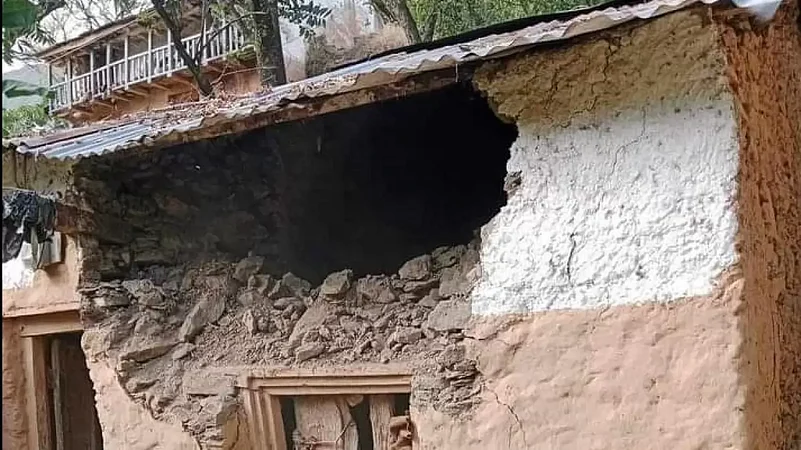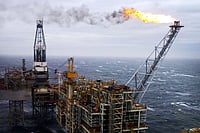A 6.2-magnitude earthquake struck Western Nepal on Tuesday. The tremors were also felt in Delhi and the surrounding National Capital Region (NCR) in India.
The earthquake, which was second in the region within an hour, came just 24 hours after a Dutch researcher said that "atmospheric fluctuations" were observed in and near Pakistan, which he said could be an indicator of a strong earthquake in the region.
The researcher, Frank Hoogerbeets, became famous by predicting the devastating the Turkey-Syria earthquake earlier this year that killed around 60,000 people. Three days before the earthquake and its many aftershocks, he had tweeted, "Sooner or later there will be a ~M 7.5 #earthquake in this region (South-Central Turkey, Jordan, Syria, Lebanon)."
Even as people discussed Hoogerbeats's tweet on the earthquake in and around Pakistan, they felt tremors on Tuesday and soon the National Center for Seismology (NCS) reported that a 6.2-magnitude earthquake has struck Western Nepal.
Scientists have, however, looked at Hoogerbeats and his research at the Solar System Geometry Survey (SSGEOS) institute with scepticism. They maintain that earthquakes cannot be predicted.
Here we explain what Hoogerbeats said in his latest prediction, how he makes such predictions, and what we know about the Nepal earthquakes.
What did Frank Hoogerbeats say?
Just a day before the Nepal earthquake, Frank Hoogerbeats on Monday said that the recent atmospheric developments in and around Pakistan could be an "indicator of an upcoming stronger tremor" in the region.
Earlier on Sunday, Hoogerbeats's institution Solar System Geometry Survey (SSGEOS) had said that "strong fluctuations" were recorded in and around Pakistan which could have a "potential for strong to major seismic event".
Sharing the SSGEOS observation, Hoogerbeats said that one could not, however, say with certainty that an earthquake would take place.
Earlier in February, three days before the devastating 7.8-magnitude earthquake struck Turkey and Syria on February 6, Hoogerbeats had said that an earthquake of a magnitude around 7.5 was likely in the region "sooner or later".
While media reports often interpret Hoogerbeats's forecasts as 'predictions', he clarified in a tweet on Monday that he and his institute share "indicators" of a probable earthquake and it does not mean that an earthquake is certain to happen in the area and the dates mentioned in their posts.
"Often when we say that there is the possibility of a stronger earthquake, rumours appear that 'there will be a big earthquake'. These rumours are false! There can be indicators, yes. But there is no certainty that it will happen," said Hoogerbeats on Twitter.
How Hoogerbeats makes his forecasts?
Frank Hoogerbeats and his Solar System Geometry Survey (SSGEOS) use a technique called "critical planetary geometry" to understand the indicators that cause earthquakes.
In simpler terms, they study the alignment of celestial bodies, including the Earth and the Moon, and the pulls and energy exerted upon the Earth by such alignments to arrive at indicators of probable earthquakes. The technique is called "critical lunar geometry" if the Moon is involved in their alignments.
"From this we conclude that the key is the condition of Earth's crust, i.e. the amount of stress between tectonic plates and whether or not a larger fault section has reached its strain budget and is ready to slip. This would indicate a direct relationship between the build-up of stress in Earth's crust and electromagnetic charge from critical planetary geometry. We say electromagnetic charge, because often a convergence of planetary conjunctions that results in a large earthquake, does not directly include Earth," says SSGEOS on its website.
Following the Turkey-Syria earthquake, which killed around 60,000 people, Hoogerbeats tweeted on March 30: "The major earthquakes on 6 February occurred near Full Moon converging with critical planetary geometry. Some scientists will simply claim that planets and the moon do not trigger earthquakes, but research on tidal stress suggests otherwise."
To back his statement, Hoogerbeats shared a research paper that explored the possible link between earthquakes and tides, which are caused by the Moon's pull.
"Tectonic tremors deep within subduction zones are highly sensitive to tidal stress levels with tremor rate increasing at an exponential rate with rising tidal stress. Thus, slow deformation and the possibility of earthquakes at subduction plate boundaries may be enhanced during periods of large tidal stress," noted the research paper titled 'Earthquake potential revealed by tidal influence on earthquake size–frequency statistics' in Nature Geoscience journal.
Can earthquakes be 'predicted'?
The broad scientific consensus is that earthquakes cannot be predicted. Even Frank Hoogerbeats says that he posts "indicators" of earthquakes and not outright predictions on a certain date in a certain area.
The United States Geological Survey (USGS) says that no one has ever predicted a major earthquake and such predictions are not expected in the foreseeable future as well. The USGS says that a "prediction" needs to have three things: 1) the date and time, 2) the location, and 3) the magnitude of earthquake.
These three things, maintains the USGS, have not been predicted accurately in a scientific manner so far. The comments taken as predictions are way too generalised to be considered as predictions, says USGS.
"Their predictions are so general that there will always be an earthquake that fits; such as, (a) There will be a M4 earthquake somewhere in the U.S. in the next 30 days. (b) There will be a M2 earthquake on the west coast of the U.S. today. If an earthquake happens to occur that remotely fits their prediction, they claim success even though one or more of their predicted elements is wildly different from what actually occurred, so it is therefore a failed prediction," says USGS.
Notably, Hoogerbeats's comment about the latest earthquake also said an earthquake was likely in the general region in and around Pakistan. There were no specifics. While Pakistan is technically near Pakistan, but so are Afghanistan, Iran, or India.
Following the Turkey-Syria earthquake, Newsweek reported Professor Ilan Kelman at the UCL Institute for Risk and Disaster Reduction as saying that while it is possible to predict where an earthquake might occur, as we have mapped geographic fault lines and tectonic plates accurately over the years, it is not possible to predict when it would occur.


























